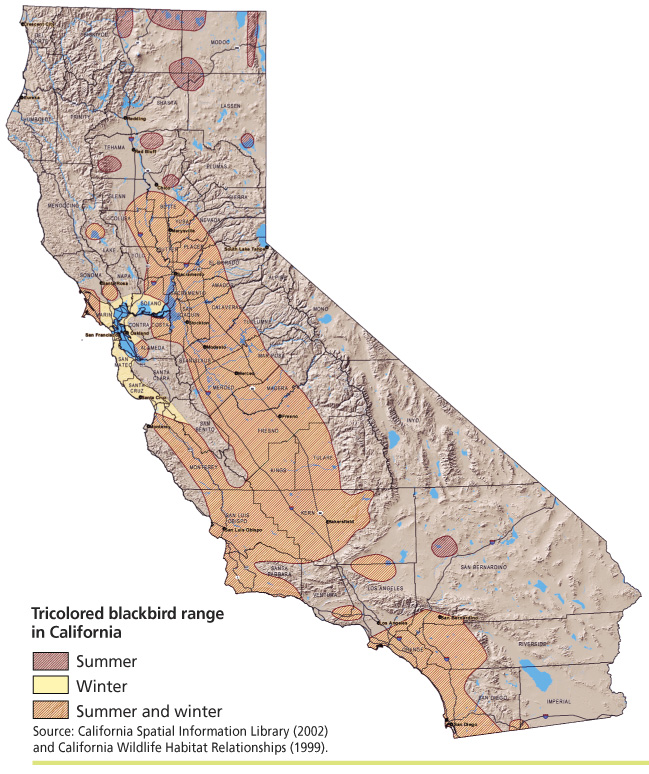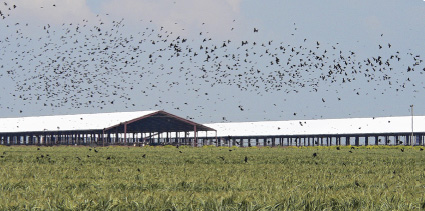All Issues
Cooperative conservation could save tricolored blackbirds
Publication Information
California Agriculture 62(2):54-54.
Published April 01, 2008
PDF | Citation | Permissions
Full text
Left, Tricolored blackbirds at Owens Creek in Merced County;Right, A nest containing four eggs in triticale
A new plan to keep the tricolored blackbird off the endangered species list will also benefit farmers. Found almost exclusively in California, the birds are down to about 260,000. More than half of the remaining tricolored blackbirds (Agelaius tricolor) nest in Central Valley triticale fields, and the crop is ready to harvest before the nestlings are ready to fledge.
“The birds and the farmers both want the triticale at the same time,” says Robert Meese, a UC Davis tricolored blackbird expert. “They're on a collision course.”
Meese is part of an alliance that developed a voluntary conservation plan for the tricolored blackbird. An agreement to implement the plan was signed in September 2007 by representatives of agricultural industry groups, conservation organizations and government agencies, as well as by Rick Standiford, ANR associate vice president. “This is a fine example of how cooperative conservation can help resolve conflicts between agriculture and natural resources,” Standiford says. The conservation plan was spearheaded by Sustainable Conservation, a nonprofit organization that seeks practical solutions to environmental problems. “By building populations now, we will avoid the need for a listing in the future,” says Sustainable Conservation's Susan Kester, who coordinates the Tricolored Blackbird Working Group that created the plan.
For more information:
Tricolored Blackbird Portal
http://tricolor.cain.ucdavis.edu
Tricolored Blackbird Project
While the historical size of the tricolored blackbird population is unknown, by all accounts it was tremendous. Wintering flocks were described as darkening the sky in 1853, the species was the most common bird in San Diego County in 1870, and a roost in Sacramento County was estimated at close to 500,000 in 1937, according to the Conservation Plan for the Tricolored Blackbird.
Likewise, the tricolored blackbird can breed in huge colonies — the largest in recent years had 138,000 adults. With the decline of the freshwater marshes where they once nested, the birds have turned to triticale grown for silage on dairy farms. “The fields are flood-irrigated so it looks like a marsh, and there's a grain pile 30 feet away,” Meese says. “It seems like nirvana to blackbirds.”
The conservation plan's short-term goals include buying silage crops on farms with breeding colonies. To facilitate these buyouts, Meese spends the April-to-July breeding season monitoring colonies in the Central Valley. “My experience with landowners has been universally positive,” Meese says. “It's not a case of ‘good guys, bad guys.’ They're just trying to make a living.”
But to farmers, blackbirds are pests, and in a typical year only one out of eight colonies breeding in triticale is saved. “It's not a slam dunk — it's just a year-to-year fix,” Kester says.
The plan's long-term goals include creating more freshwater marsh to tempt tricolored blackbirds away from farms. This approach is promising because when given the choice, the birds prefer nesting in cattails. The birds also need a convenient source of insects, which females depend on for producing eggs and which are all the nestlings eat. Alfalfa and sunflower fields provide insects in agricultural areas, while shrublands provide them in the wild. Again, when given the choice, the birds prefer foraging in natural shrublands.
Due to habitat loss, colonies of tricolored blackbirds have been nesting in fields of triticale, but the crop is usually harvested before nestlings have fledged. A new agreement will help restore the bird's habitat. Above, A male tricolored blackbird in the breeding season
But before restoring breeding habitat, the group still needs to know more about the tricolored blackbirds' basic behavior. “They're often itinerant breeders and may not return to the same exact sites each year,” Kester says. “What characteristics are they looking for?”
To find out what attracts the birds, she envisions testing various land-management techniques in the Kern and San Luis National Wildlife Refuges. For example, the birds seem to like lush, young growth in wetlands, which could be created by controlled burns or disking. Another priority is setting targets for how many birds there should be, and how much new breeding habitat they would need to stay away from farmers' fields.
“If there was enough marsh, I think that to a large extent the problem would go away,” Meese says. Then dairy farmers would be able to make a living and the tricolored blackbird would be able to keep on living.








